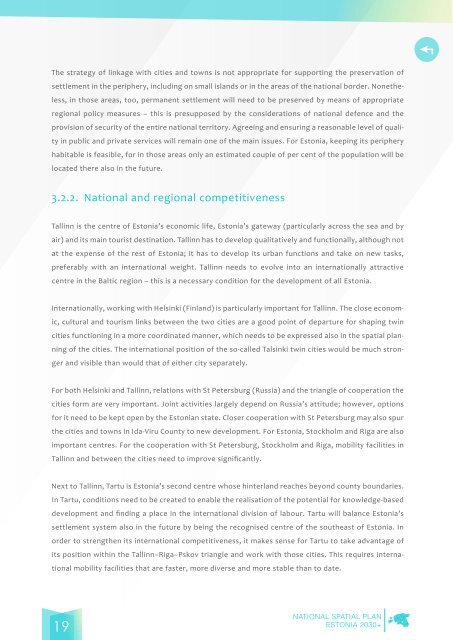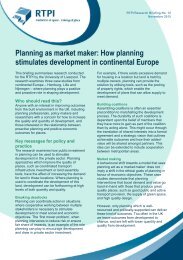estonia-2030_en
estonia-2030_en
estonia-2030_en
Create successful ePaper yourself
Turn your PDF publications into a flip-book with our unique Google optimized e-Paper software.
The strategy of linkage with cities and towns is not appropriate for supporting the preservation ofsettlem<strong>en</strong>t in the periphery, including on small islands or in the areas of the national border. Nonetheless,in those areas, too, perman<strong>en</strong>t settlem<strong>en</strong>t will need to be preserved by means of appropriateregional policy measures – this is presupposed by the considerations of national def<strong>en</strong>ce and theprovision of security of the <strong>en</strong>tire national territory. Agreeing and <strong>en</strong>suring a reasonable level of qualityin public and private services will remain one of the main issues. For Estonia, keeping its peripheryhabitable is feasible, for in those areas only an estimated couple of per c<strong>en</strong>t of the population will belocated there also in the future.3.2.2. National and regional competitiv<strong>en</strong>essTallinn is the c<strong>en</strong>tre of Estonia’s economic life, Estonia’s gateway (particularly across the sea and byair) and its main tourist destination. Tallinn has to develop qualitatively and functionally, although notat the exp<strong>en</strong>se of the rest of Estonia; it has to develop its urban functions and take on new tasks,preferably with an international weight. Tallinn needs to evolve into an internationally attractivec<strong>en</strong>tre in the Baltic region – this is a necessary condition for the developm<strong>en</strong>t of all Estonia.Internationally, working with Helsinki (Finland) is particularly important for Tallinn. The close economic,cultural and tourism links betwe<strong>en</strong> the two cities are a good point of departure for shaping twincities functioning in a more coordinated manner, which needs to be expressed also in the spatial planningof the cities. The international position of the so-called Talsinki twin cities would be much strongerand visible than would that of either city separately.For both Helsinki and Tallinn, relations with St Petersburg (Russia) and the triangle of cooperation thecities form are very important. Joint activities largely dep<strong>en</strong>d on Russia’s attitude; however, optionsfor it need to be kept op<strong>en</strong> by the Estonian state. Closer cooperation with St Petersburg may also spurthe cities and towns in Ida-Viru County to new developm<strong>en</strong>t. For Estonia, Stockholm and Riga are alsoimportant c<strong>en</strong>tres. For the cooperation with St Petersburg, Stockholm and Riga, mobility facilities inTallinn and betwe<strong>en</strong> the cities need to improve significantly.Next to Tallinn, Tartu is Estonia’s second c<strong>en</strong>tre whose hinterland reaches beyond county boundaries.In Tartu, conditions need to be created to <strong>en</strong>able the realisation of the pot<strong>en</strong>tial for knowledge-baseddevelopm<strong>en</strong>t and finding a place in the international division of labour. Tartu will balance Estonia’ssettlem<strong>en</strong>t system also in the future by being the recognised c<strong>en</strong>tre of the southeast of Estonia. Inorder to str<strong>en</strong>gth<strong>en</strong> its international competitiv<strong>en</strong>ess, it makes s<strong>en</strong>se for Tartu to take advantage ofits position within the Tallinn–Riga–Pskov triangle and work with those cities. This requires internationalmobility facilities that are faster, more diverse and more stable than to date.19




